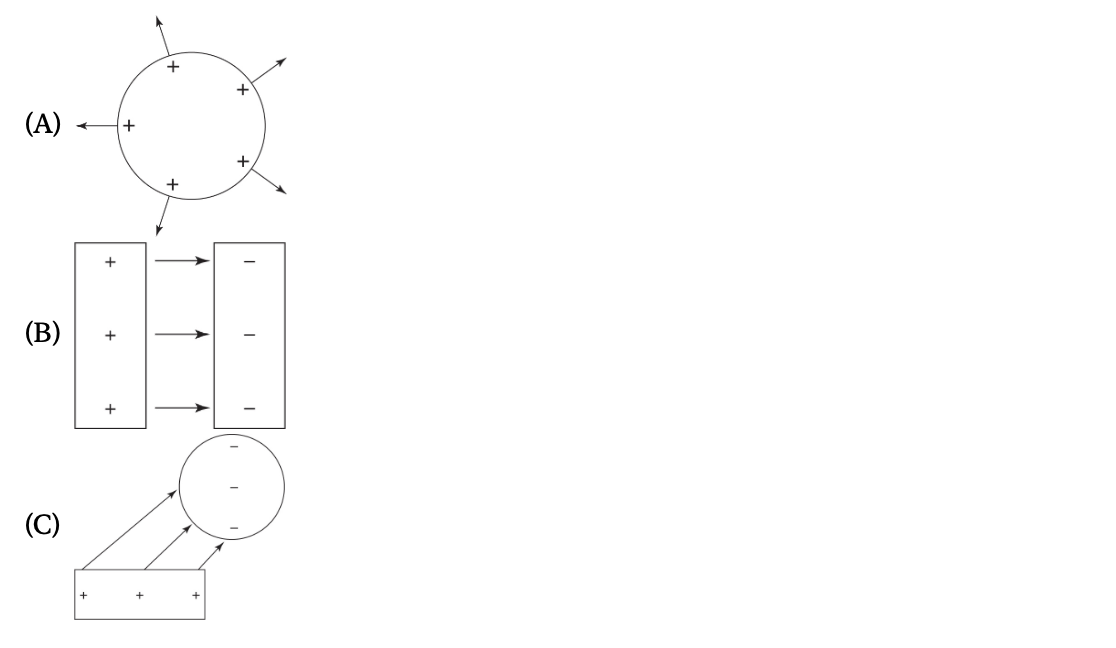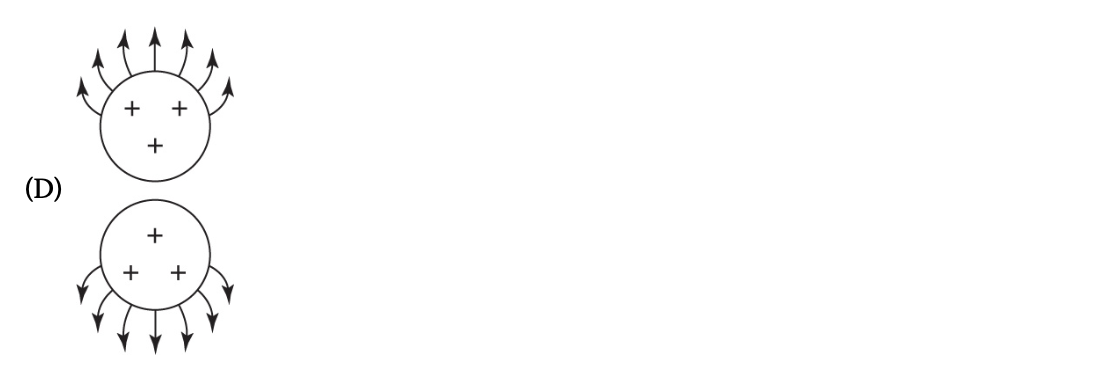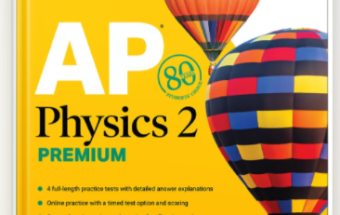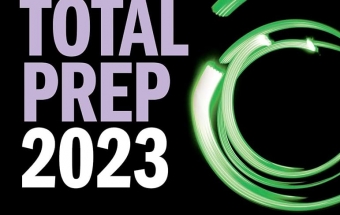AP Physics 2 Premium, 2024 - Diagnostic Test
SECTION I: MULTIPLE-CHOICE
1. Compare the two columns of water pictured below. They have the same height. Which of the following statements compares the total weight and the pressure at the bottom of the columns?

(A) Weight and pressure are greater for the wider column.
(B) Weight and pressure are the same for both.
(C) Weight is greater for the wider column, while pressure is the same.
(D) Weight is the same, while pressure is greater for the wider column.
2. .The exact same boat will ride higher (have more volume exposed to the air) while floating on a fluid if
(A) the fluid’s density is raised
(B) the fluid’s temperature is raised
(C) the boat’s density is raised
(D) the boat shifts its cargo to a lower deck
3. Fluid is poured into an open U-shaped tube as shown below. If a person blows across the top of the right-hand side’s opening, what will happen to the fluid in the tube?

(A) It will remain the same.
(B) It will rise on the right-hand side and lower on the left-hand side.
(C) It will rise on both sides.
(D) It will rise on the left-hand side and lower on the right-hand side.
4. The Sun’s rays strike a black surface that is directly on top of a liquid. The liquid is then observed to swirl as it transfers the heat to the bottom layers of the liquid. The correct sequence of transfers in thermal energy in this story is
(A) Radiative → convective → conductive
(B) Radiative → conductive → convective
(C) Convective → conductive → convective
(D) Convective → conductive → radiative
5.Which of the following is the best explanation of the statement, “A roomful of neon gas has a lower average speed than 1 mole of helium gas at the same temperature and pressure.
(A) This is not a correct statement.
(B) There is more than 1 mole of neon gas in an average room.
(C) Helium atoms have more degrees of freedom than do neon atoms.
(D) Helium has a lower mass per particle than neon.
6.Consider the following process for a gas. Which of the following statements is true concerning this process?

(A) Path D (from point 4 to point 1) is isobaric.
(B) No work was done to or by the gas during path A (from point 1 to point 2).
(C) No net work was done to or by the gas during the entire cycle (from point 1 back to point 1 through A, B, C, D).
(D) No work was done to or by the gas during path B (from point 2 to point 3).
7. Two identical spheres originally in contact undergo induced charge separation. The two spheres are slowly separated until a gap of 12 cm is separating their surfaces. The net force of attraction between the two oppositely charged large spheres after they have been separated by 12 cm is measured. The entire experiment is then repeated with two smaller but otherwise similar spheres.

The force between the smaller spheres compared with the force between the larger spheres is best described as
(A) the same since the charges and separations are the same
(B) smaller since the charges on each small sphere are closer together
(C)bigger since the centers of the spheres are closer
(D) the same since the average force felt by any one particular charge is the same in both cases
8. One large conducting sphere with a net charge of +8 microcoulombs is put into contact with a slightly smaller conducting sphere that initially has a charge of –6 microcoulombs. Which statement best describes the charge distribution after the two spheres are separated?
(A) They are both neutral.
(B) The larger sphere has +8 microcoulombs of charge, while the smaller retains –6 microcoulombs of charge.
(C) Both spheres have +1 microcoulomb of charge.
(D) The larger sphere has slightly more than +1 microcoulomb of charge, while the smaller sphere has slightly less than +1 microcoulomb of charge.
9. Which of the following pictures is an incorrect representation of the electric field near various charged conductors?


10.A standard RC (resistor-capacitor) circuit takes approximately two seconds to charge the capacitor fully. If the resistor is 100 ohms and the voltage across the RC combination is 12 volts, what is the current through the fully charged capacitor?
(A )One must know the capacitance of the capacitor in order to answer this question.
(B) 0.12 A
(C) 0.06 A
(D) 0 A
11. If each of the batteries in the circuit below supplies a voltage V and if each resistor has resistance R, what will be the reading on the meter pictured?

(A) 0
(B) V/3
(C) 2V/3
(D) 2V/3R
12. The primary difference between a permanent magnet (an object with identifiable north and south poles) and magnetic material that does not have identifiable north and south poles is
(A) electron configuration
(B) magnetic domain alignment
(C) magnetic materials have no poles at all
(D) magnetic materials are lacking one of the two poles
13.A very long wire carries a steady current. Which of the following statements describes the magnetic field at a distance of R from the wire?
(A) The magnetic field is zero.
(B) The magnetic field loops around the wire and gets weaker proportional to 1/R2 as one moves to larger R values.
(C) The magnetic field loops around the wire and gets weaker proportional to 1/R as one moves to larger R values.
(D) The magnetic field extends radially outward and gets weaker proportional to 1/R2 as one moves to larger R values.
14.Two parallel wires carrying current near each other exert magnetic forces on each other. If the direction and magnitude of the current in both wires is reversed and doubled, what will happen to the magnetic forces
(A) They will reverse directions and double in magnitude.
(B) They will reverse directions and quadruple in magnitude.
(C) They will remain in the same directions and double in magnitude.
(D) They will remain in the same directions and quadruple in magnitude.
15. A conducting loop of wire is held steady parallel to the ground within a strong magnetic field directed upward. The setup is viewed from above. As the loop of wire is quickly pulled out of a magnetic field, what will the loop experience?
(A) A temporary clockwise current that dies out soon after the loop is out of the field
(B) A temporary counterclockwise current that dies out soon after the loop is out of the field
(C) A temporary clockwise current that dies out as soon as the loop is out of the field
(D) A temporary counterclockwise current that dies out as soon as the loop is out of the field
16. A charge is accelerated by an electric field. While the charge is accelerating, which of the following is occurring?
(A) A static magnetic field is created.
(B) A new, static electric field is created.
(C) Only a varying magnetic field is created.
(D) An electromagnetic wave is created.
17. A light beam is traveling in a vacuum and then strikes the boundary of another optically dense material. If the light comes to the interface at an angle of incidence of 30 degrees on the vacuum side, it will emerge with an angle of refraction
(A) equal to 30 degrees
(B) less than 30 degrees
(C) greater than 30 degrees
(D) The relative indices of refraction must be known in order to find the solution.
18. A beam of light incident at 50 degrees travels from a medium with an index of refraction of 2.5 into one with an index of refraction of 1.1. The refracted angle of light that emerges is
(A) 20 degrees
(B) 50 degrees
(C) 90 degrees
(D) There is no solution.
19. A radio telescope uses a curved reflecting material to focus radio signals from orbiting satellites or distant objects in space onto a detector. Which of the following would be the biggest problem with designing a radio telescope with a convex reflecting dish?
(A) The image produced is virtual.
(B) The image produced is inverted.
(C) The detection equipment would have to be placed in the line of sight.
(D) There is no real problem with designing a convex reflecting dish for radio waves.
20. When examining a two-slit diffraction pattern, which of the following would you notice as the slits were brought closer together?
(A) The interference pattern would contain more maximums. They would be more closely spaced.
(B) The location of the central interference peak would shift.
(C) The interference pattern would spread out.
(D) The interference peaks themselves would each become sharper (narrower).
21. A radioactive isotope undergoes gamma decay. Afterward, the nucleus
(A) contains fewer nucleons
(B) has the same number of nucleons but a different ratio of protons/neutrons
(C) has the same mass number but a lower mass
(D) undergoes beta decay
22. When examining the spectrum for a specific element, a bright spectral line with the highest frequency represents
(A) an electron excited to the atom’s highest energy state
(B) an electron falling from the highest energy state in the atom to the next to highest state
(C) an electron excited from its ground state to the next to lowest energy state
(D) an electron falling from a higher energy state to a much lower energy state
23. Some objects can be made to exhibit an interference pattern with the two-slit experiment, and some objects cannot. What is the difference between those that can and those that cannot?
(A) Objects are either fundamentally a wave or fundamentally a particle.
(B) All objects can exhibit either wave-like properties or particle-like properties depending on the situation.
(C) Whether an interference pattern can be observed depends on the object’s de Broglie wavelength.
(D) All objects can be made to exhibit an interference pattern under the right circumstances.
24. For an RC circuit, which of the following is the correct analogy for the instantaneous current behavior in a pathway containing a capacitor? Choose the option that would give the correct instantaneous current values in the capacitor’s path.

25. Which of the following statements are true concerning isolated fundamental particles? Select two answers.
(A) An isolated fundamental particle cannot have charge.
(B) An isolated fundamental particle cannot have potential energy.
(C) An isolated fundamental particle cannot have internal energy.
(D) An isolated fundamental particle cannot have mass.
26. A convergent lens can produce which of the following from a single object in front of the lens? Select two answers.
(A) Real and upright image
(B) Virtual and upright image
(C) Real and inverted image
(D) Virtual and inverted image
SECTION II: FREE-RESPONSE
1.Use the following circuit to answer the questions below.
(a) When the capacitor is still uncharged and the switch is initially closed, how much current goes through the battery? Explain your reasoning.
(b) After the capacitor has been fully charged, how much current is being supplied by the battery? Explain your reasoning.
(c) After the capacitor has been fully charged, the battery is removed, leaving an open circuit where the battery was just located. Determine:
(i)The direction of current through the 10-ohm resistor
(ii)The total amount of charge that passes through the 10-ohm resistor
(iii)The initial instantaneous current after the battery has been removed
(iv)The approximate time for the capacitor to be half-discharged
2. A student is provided with a solenoid attached to an ammeter and with a bar magnet. The student monitors the ammeter as she performs the following sequence of events. Describe qualitatively her observation of the ammeter (comparing current sign and magnitude) at each step of her procedure.
(a)The student slowly inserts the north pole of the bar magnet into the solenoid.
(b)She holds the magnet steady at this location.
(c)The student withdraws the magnet quickly from the solenoid.
(d)She repeats the steps but uses the south pole of the magnet.
What factors about this procedure and the equipment affect the magnitude of current observed?








